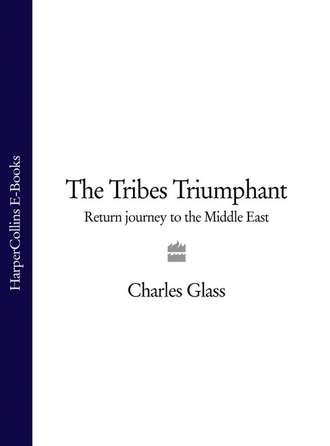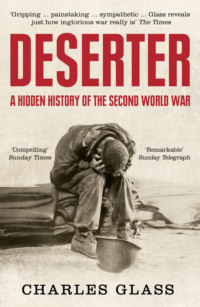
Полная версия
The Tribes Triumphant: Return Journey to the Middle East
He dropped his pipe in an ashtray and jumped up to find a book. Then another. He handed them to me. One was Robert Friedman’s Zealots for Zion and the other Dilip Hiro’s Sharing the Promised Land. ‘Look on page ninety-nine,’ he said, pointing at the Friedman book. There it said that an Armenian named Martyros Matossian had received $3.5 million to assign his family’s protected tenancy in the hospice to a group of Israeli settlers. The Hiro book, on page twenty-two, made the same allegation, but said Matossian, who then fled the country, received $5 million.
Albert explained that most of the property in the Christian Quarter belonged to the churches – with the Greek Orthodox owning most. ‘For example,’ he said, ‘my mother has leased her house from the Greek Orthodox Patriarchate since 1932. The leases are with local tenants, and tens of people in a family could have shares in the same house. The settlers find the one who needs money. They ask him to sell his room in the house. Then they elbow their way in.’ Albert knew families who had settlers in one cramped bedroom of their house. ‘If there is an explosion,’ he said, meaning a Palestinian bomb targeting Israelis anywhere, ‘the settlers will get angry and beat everyone in the house. They go on the rooftop and pee in the water tank.’
The old city settlers were, for the most part, extremely religious. ‘Traditionally, the Jewish religious establishment opposed Zionism,’ Albert said. ‘Ben-Gurion told them, we have a state and it must be based on the rule of law. We have conscription. We have state education. We have public transport on Saturday. The money we receive is for all the Jewish people. You must reach an accord with us. And they did. It was the new status quo.’ The religious establishment, who believed Jewish nationalism contradicted the centrality of Jewish faith, arrived at a mode of co-existing with the state. The religious were exempt from military service. They sent their children to religious, rather than secular state, schools. Public transport did not trespass in their neighbourhoods on the Sabbath. They took a share of government expenditure to disburse among their own as they saw fit.
‘From 1948 to 1967,’ Albert recalled, ‘the father of Avraham Burg, the speaker of the Knesset … his father, Yossef Burg, was the longest-serving Knesset member. As head of the National Religious Party, he served in all of Israel’s governments. He did not get involved in Israeli politics. Instead, he represented religious interests. It created a strange relationship. He used your money to attack you, the government. After 1967, a completely new relationship emerged.’ The religious colleges, the Yeshivas, developed a new theology and, with it, a new politics. ‘Their interpretation was original. For the first time, they said, we now have Hebron. We have Jerusalem. This means we are living in Messianic times. Our mission is to redeem the land. This line of reasoning surfaced in 1972 in Hebron when the Gush Emunim grabbed its first settlement.’
Gush Emunim, Bloc of the Faithful, settled in a Hebron hotel. To persuade them to leave the centre of the Arab city, the Labour government allowed them to establish Kiryat Arba on a hill it confiscated above Hebron. ‘After Kiryat Arba, the religious settlements began to proliferate, like amoebae, under different names: Ne’vot David at St John’s, El Ad and the rest. These are now the people who are holding the government by the balls.’ The settlers had also returned to Hebron, where they regularly abused and attacked the Arab inhabitants. One of them, Baruch Goldstein, had shot and killed twenty-nine men in the Grand Mosque.
Albert showed me one of the settlers’ slogans, in English, on that most American of political advertising media, the bumper sticker: ‘G*d is a religious Zionist.’ He laid some of their literature, booklets and pamphlets on the table. There were biblical passages from Genesis, Exodus, Deuteronomy and Joshua on ridding the land of Canaanites and Philistines. ‘I predict,’ Albert said, as if sermonizing from a pulpit, ‘that within ten years, the religious will take over the army.’ The army, in Albert’s view, was already leading the country. Sharon remained more soldier than politician. His tanks and helicopters swarmed all over the West Bank and Gaza, but he did not know how to pass a budget. ‘This is a government that serves the army,’ he said. ‘How far can this go?’
From time to time during my stay in Jerusalem I would stop by Madeleine’s kitchen. It was no accident that my visits often coincided with lunch. She cooked well, and her food was the closest to Lebanese in Jerusalem. Neither the Palestinians nor the Israelis were great cooks, but the Lebanese and Armenians were. Among the Armenians, Madeleine Agazarian was one of the best. I understood why Albert and the children lunched at home almost every day. It was rare that I was the only guest. Sometimes, George Hultunian was there in a tattered cardigan. Often, women of the Armenian Quarter or further afield appeared. There were occasional academics and journalists, but I never saw a priest.
During one lunch, the women were talking about ‘the settler’. There were so many settlers in old Jerusalem that I did not know why they singled out this particular man. Madeleine and one of her friends had seen wives of the Arab labourers who had worked for him restoring his old house. They were standing outside his door, begging for their husbands’ unpaid wages. One of them had a small baby. ‘Haram,’ one of the Armenian women said. Pity. I asked what was going on, and Albert said it was not important. I pressed the women, and they told me the story.
‘The settler’ was an American, who had taken a house on Ararat Street next to St Mark’s Syrian Orthodox Church. It was at the edge of the Armenian Quarter, not far from Habad Street in the Jewish Quarter. The house he took needed work, and he hired Arabs to do it. When the time came to pay them, he replaced them with other workers. The labourers demanded their wages, and he ignored them. They were afraid to tell the police. Arabs from the occupied territories could not approach the authorities without being arrested themselves for working without permits. Their wives went to the settler’s house to shame him. But, the women said, he refused to give them any money. It was the scandal of the Armenian Quarter, and no one had the power to make the settler pay.
In the evening, I walked from Armenian Patriarchate Road into St James’s Road, a footpath too narrow for cars. At the Ararat Grocery, I asked the way to St Mark’s. ‘That’s my church,’ the young man behind the counter said, not without pride. There were a few hundred Syrian Orthodox in Jerusalem, and he was one. He took me outside, and under the feeble lamps of the ancient city carefully pointed the way. Passing under the arches, the vaults and sky, I found the Church, no larger than a small chapel, of St Mark. Behind it, extending in a graceful curve over the lane, was the house of the American settler. I recognized it by the new, unfinished cement steps built by the unpaid workers. A ramp, with two-by-fours nailed to it, led to the front door. This was where the neighbours said the workmen’s wives had stood crying and begging for the money their husbands had earned. I went to the door, but no one was home. What was I going to say? Would I tell him, American to American, to pay the men? Or would I ask him for his side of the story? Taking a man’s labour without paying him was slavery, and we had fought a civil war over that.
The Room Down
Next door in St Mark’s Church I met the remarkable Sister Yostina al-Banna. An orthodox nun from Nineveh, which she called ‘the great city of Jonah’, she had three brothers who were priests. One of the three, George Yusuf al-Banna, taught geology at a university in Portland, Oregon. The second lived in Jordan, and the third was still in Nineveh. Sister Yostina had left Iraq, homeland of most Syrian Orthodox, little more than a year before.
‘This is the first church in Christianity,’ she said, making it one of the many first churches I have seen. The early Christians had no churches. They gathered in synagogues and, when uncircumcised Gentiles were admitted to their communities, in one another’s houses. They gave themselves the name Christian at Antioch, where I visited a cave in 1987 that also claimed the distinction of first church. The Turks had turned it into a museum. St Mark’s was still a church.
Sister Yostina said St Mark’s, built in AD 37, had been destroyed three times. ‘The first time was in 71, when the King Titus come to this city and destroy Jerusalem. Everything high, he cut it. The twelfth century was the last time.’ The nun, like the church itself, was old and small. But, also like the church, warm and welcoming. She showed me an Aramaic inscription that she said had been discovered in 1940. Aramaic, or Syriac, was the language of Palestine, spoken by Jews as well as Gentiles, at the time of Christ. The Syrian Orthodox still used it for their liturgy, as Lebanon’s Catholic Maronites did until Vatican II instructed them to use the vernacular. She said of the inscription, ‘It’s old, fifteen hundred years old. It is written in Aramaic, the language of Jesus, from right to left.’ Then she translated it: ‘This is the house of St Mark’s mother, who was chosen of Christ from the Apostles.’
St Mark’s mother, Mary, lived in the house below the church. That was the legend. If true, it was where St Peter took refuge when the angel helped him out of prison. The church was a museum of Christian legends. ‘In the upper room of the house down [down meant the levels below the church itself], Jesus made the Last Supper,’ she told me, adding another astonishing detail, ‘and, also, the washing of the feet.’ The Virgin Mary, she believed, was baptized here; although the New Testament did not mention her baptism. There were more stories, not all of which I understood.
Sister Yostina said, ‘Jesus sent St Peter and St John. He told them, “You shall enter the city Jerusalem, and you shall see a man carrying a jar.” In those days, only women carry jar. This was the miracle from God. St Mark went and stand and carry a jar. And they follow Him until He reach the house of his mother. So, they prepare for Him the upper room of the house down.’ That was not all. ‘After the cross, the Apostles with the Virgin Mary were afraid. They don’t know where they can go. They are strange in this city, so they turn back to the house of St Mark’s mother. They remain three days, until Jesus appear to them, after He be in this life, after three days.’
Конец ознакомительного фрагмента.
Текст предоставлен ООО «ЛитРес».
Прочитайте эту книгу целиком, купив полную легальную версию на ЛитРес.
Безопасно оплатить книгу можно банковской картой Visa, MasterCard, Maestro, со счета мобильного телефона, с платежного терминала, в салоне МТС или Связной, через PayPal, WebMoney, Яндекс.Деньги, QIWI Кошелек, бонусными картами или другим удобным Вам способом.




